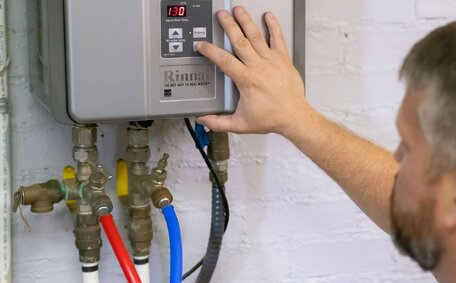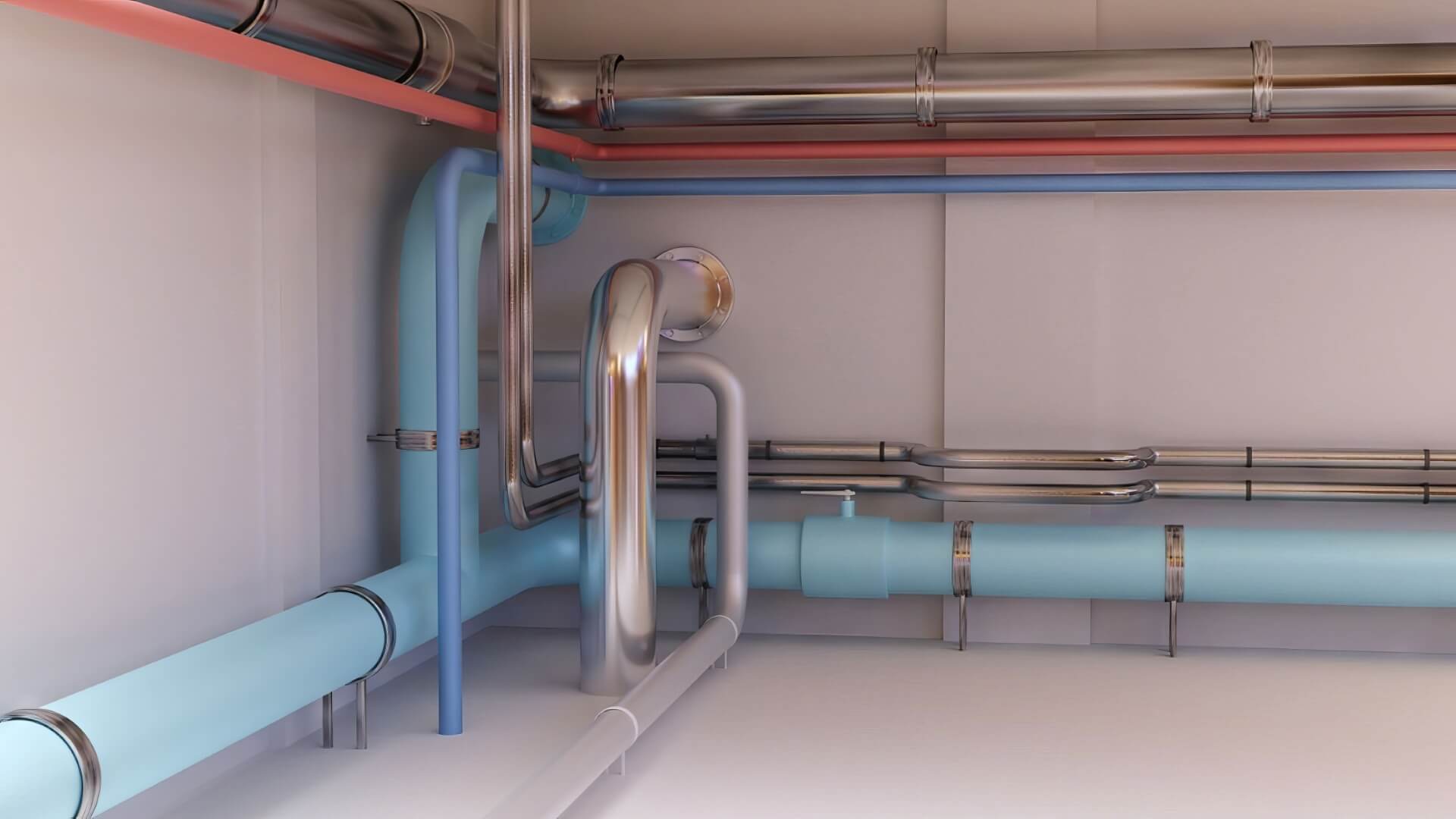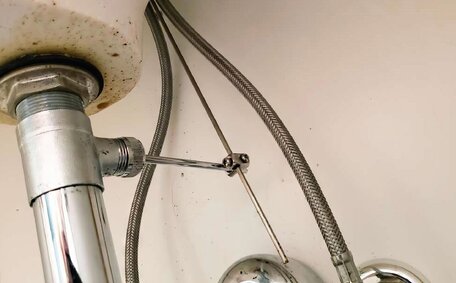Introduction to Water Heater Lifespans and Maintenance Needs
Reliable hot water systems are essential to prevent water heater failure in homes. After serving well for a period reaching ten years, the average tankless water heater advances towards the end of its functional lifespan and may require replacement. With regular inspection and maintenance, you can learn more about your heater and make it more resilient, extending its longevity and preventing heater failure.
Water heaters need regular care for sustained optimal performance. Key maintenance tasks involve checking connections for leaks, flushing the tank to reduce sediment buildup in your systems, testing pressure relief mechanisms, replacing anode rods, and learning about your heater’s electrical components on electric models. Addressing minor repairs promptly can prevent them from escalating into major issues later.
By understanding what to look for, homeowners can notice your hot water system’s performance lagging, potentially signalling it’s time for a replacement. Proactive maintenance involves early detection of water heater issues to circumvent malfunctions and stress from heater failure.
Common Noises Indicating Water Heater Issues
Various strange noises from your water heater, like popping, rumbling, or cracking, often signal a failing hot water system that needs attention. These are commonly due to sediment buildup, indicators of a hot water system failing, or a pressure imbalance.
Popping or banging noises generally stem from sediment build up which your heater needs to be checked for in the water heater tank. As the sediment that has built up over the years old collects at the bottom, it eventually hardens and gets heated, causing noise as it expands and contracts.
A rumbling or gurgling water heater usually indicates potential issues with your unit, like a failing heating element or faulty thermostat prompting rapid cycling. Such unstable heating can cause water turbulence, potentially disrupting your hot water usage.
Other issues, at the beginning to fail, like air conditioning malfunctions, the need to test tpr valve for faults, leaks or loose fittings can lead to unusual noises you’ll want to get inspected. Make note of any concerning sounds from your water heater so a technician can accurately troubleshoot the problem.
Strange Smells Coming From the Water or Water Heater
Unusual smells in water can often act as a warning sign, which your family might begin to notice, hint at bacterial growth or corrosion issues, may even indicate the presence of carbon monoxide from your water heater and need prompt attention. Some common concerning odours include:
- Rotten egg’ smell - Caused by sulphur bacteria buildup inside the tank, hinting at the need for maintenance. This bacteria isn’t harmful but suggests signs failing water heater components that could be due to needing attention.
- Chlorine smell - Corrosion inside the tank releasing chlorine from the water supply into the air.
- Sewage or rotten smells - Bacterial accumulation due to sediment buildup or high water temperatures promoting growth.
These unpleasant water heater smells are typical signs your water heater is declining in performance, often worsening over time. Bacteria growth and corrosion within your water heater tank can indicate deterioration and risk contaminating your water supply, posing health hazards if consumed. Bad smells also signal your water heater going through the natural wear and tear process, becoming prone to leak or failure.
If you notice strange or unpleasant water smells coming from your hot water, contact a technician to inspect your water heater. They can troubleshoot the cause, flush the tank if needed, and confirm if a replacement is required to address corrosion and potential water supply contamination.
Visible Signs of Wear Like Rust and Sediment Buildup
There are some clear visual clues indicating your water heater is ageing and potentially failing. Rust spots on the outside of the tank or in your hot water heaters signal the onset of corrosion issues within the system. You may also notice sediment or mineral deposits, informing you about your water heater’s condition, flowing from taps or accumulating at the bottom of the tank over years.
Rust formation and flaking can create small pinhole leaks that typically worsen over time.
Check around the water heater tank exterior and pipes for any rust spots. Also inspect for Yellow pilot light issues presenting as rusty water coming out of your hot taps after water sits unused overnight. Rust particles or cloudy brown residue are warning signs of a water heater going bad due to corrosion inside the tank.
If present, or if you experience the disappointing yellow pilot light flame issues no one wants, your tank likely needs flushing.
Drain your hot water taps first thing in the morning before any water flowing to check your water tank. Catch some of the flow in a white bucket to check for sediment sludge, which settles overnight. Sediment buildup is another red flag, reducing heating efficiency and tank life expectancy.
While some wear is expected, excessive rust or sediment buildup are signs failing water heater elements that could be approaching failure. Have a technician inspect at the first signs. They can troubleshoot issues early before major leaks or cracks form, potentially avoiding a full replacement.
Fluctuating or Insufficient Hot Water Supply
Inconsistent or inadequate hot water supply often indicates a failing water heater. There are several potential causes to check:
- Faulty thermostat - If the water temperature fluctuates between hot and cold, the unstable water temperature or pressure regulating your heater may be malfunctioning. This inexpensive part often wears out before other components.
- Failing heating elements - Electric water heaters rely upon metal heating elements, components that a failing hot water heater can often have issues with due to corrosion. If they fail, you might suddenly have no hot water when your household most needs it or only intermittent heat.
- Sediment buildup - Heavy mineral deposits from hard water accumulating in the bottom tank can also cause issues by surrounding heating elements, reducing their efficiency. Flushing the tank can often restore consistent water temperatures.
- Low water pressure - Check your cold water supply pressure at sinks. a lack of strength in water pressure can prevent your unit from maintaining an adequate supply to get hot water from being able to provide hot water adequately.
- Leaky plumbing - Small leaks, often going unnoticed, can be the issues that can occur, causing heat to escape from your gas hot water system’s pipes and tank. Listen for hissing sounds near connections, where leaks are most likely to occur.
Contact a plumber for same day service if you encounter fluctuating or inadequate hot water, as swift action can mitigate storage tank problems needing hot water system repair. Replacing faulty parts like elements and thermostats can often restore consistency. On the other hand, if other internal components are deteriorating, your best option is likely to install a new water heater and employ a complete replacement to avoid leaks or ruptures down the road.
Signs of Leaks Around the Water Heater
Finding moisture or evidence of leaks like drips or puddles around your water heater is cause for immediate concern. Leaks point to tank corrosion, loose fittings or a failing pressure relief valve.
Small leaks may signal bigger system failures, leading to mould, water damage, bacterial growth illnesses, or other serious hazards. Rust-laden puddles are clear indicators of internal water heater issues. Watch for tiny drips near fittings and pipe connections too.
Don’t delay inspection at the earliest sign of moisture or drips around your system. A technician can pinpoint the origin and troubleshoot leaks early before catastrophic tank failures happen. Getting ahead of issues allows for repairs or replacement on your terms rather than emergency fixes.
Annual checks of your hot water system can prevent costly repairs. Technicians ensure all components operate safely, identify corrosion, and can provide insights about your heater’s lifespan when it’s about to exceed due to significant wear. If replacement is advised, you can budget appropriately rather than face sudden, costly damages from leaks going unnoticed too long.
When to Call a Professional for Assessment or Replacement
As a water heater ages, keeping up with maintenance becomes crucial. But even with diligent care, there comes a time replace all heaters as they reach the end of their lifespan. Relying on professional assessment to decide 'Should I replace my water heater?' rather than guessing on the timing of replacement protects you from extensive damages.
We recommend contacting Glenwood Plumbing for inspection when you notice multiple symptoms suggesting impending failure. This includes persistent sediment, leaks, rust accumulation and unusual noises or smells. A technician can troubleshoot issues, advise if repairs may extend lifespan or determine whether replacement should happen before catastrophic tank failure.
While fixes like flushing and anode rod replacements help temporarily, once corrosion and leaks begin, your days with that water heater are generally numbered. Glenwood’s plumbers inform you upfront when the extent of wear no longer warrants additional repairs. This transparency keeps you informed to budget for and plan to replace your water heater appropriately.
Ultimately when safety, property damage risks and repair costs escalate, replacement is the prudent option over squeezing out a little extra lifespan.Glenwood Plumbing focuses on your best interest, guiding you to that replacement threshold before disaster strikes your home.Reach out to us today at 1300 349 338 or [email protected] to schedule an inspection or discuss replacement options if you suspect your water heater is failing.
Proactive Maintenance to Extend the Life of Your Water Heater
Regular maintenance is critical for extending your water heater’s lifespan and saving on future repairs. Simple annual tasks like flushing sediment or installing new hot water heater components, such as anode rods, can add years of operation.
Flushing the tank regularly enhances water heater efficiency and prevents damaging mineral buildup. Sediment also harbours bacteria.
Checking and replacing your anode rod to mitigate corrosion inside tank walls is another key practice. Doing so avoids interior tank corrosion, leaks and rust-coloured water.
These rods actively corrode to protect the tank; without timely checks, your tank could face accelerated deterioration. Inspect annually and replace when eroded.
Also have professionals conduct yearly inspections to test all functions and identify early wear signs needing attention. Technicians can troubleshoot issues, flush sediment or restore consistency with affordable part replacements.
Preventative care lowers the risk of breakdowns and averts expensive failures. But when multiple warning signs appear, replacement may be imminent. With Glenwood Plumbing’s transparent guidance, you can make informed decisions regarding water heater maintenance vs replacement to protect your home and budget.






